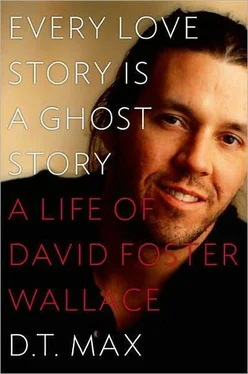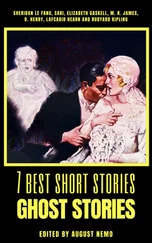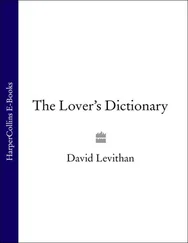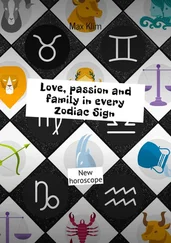The eagerly awaited next novel was on reviewers’ minds as well. Where was it? The Houston Chronicle hypothesized, generously, that it was already written, imagining a “forest-killing manuscript à la the thousand-page Infinite Jest” that was at that very moment “devouring the time and energy and quite possibly the soul of a senior New York editor.” Wyatt Mason in the London Review of Books , after a skillful elucidation of the title story, wrote:
Wallace has the right to write a great book that no one can read except people like him. I flatter myself to think that I am one of them, but I haven’t any idea how to convince you that you should be, too; nor, clearly, does Wallace. And it might not be the worst thing in the world, next time out, when big novel number three thumps into the world, were he to dig deeper, search longer, and find a more generous way to make his feelings known.
Chiding notices were harder for Wallace than the pans, which he expected by now — he could ignore critics calling for more salt in the soup — because for him, too, all roads led back to his “more generous” Long Thing, The Pale King . He had hoped at times while he was writing them that the stories in Oblivion would show a way out of the dead end Infinite Jest seemed to have left him in. He boasted to Costello that in writing it he had “looked straight into the camera.” He meant that he had finally surmounted the need to have readers love him. The mania was gone; only a studied and mature sadness remained. But to his disappointment he didn’t find that the story work suggested how to write a novel of similar honesty. The problem may have been that Wallace’s approach to Oblivion —the trick-free prose, the Pynchon-free plots, the insistence that the reader work for his or her satisfaction — was simply too pitiless to carry a reader through a novel. And while Oblivion was descriptive, The Pale King was supposed to be prescriptive. It had to convince the reader that there was a way out of the bind. It had to have a commitment to a solution that Oblivion lacked. 8Wallace had settled on his thesis long before. As he wrote in a notebook:
Maybe dullness is associated with psychic pain because something that’s dull or opaque fails to provide enough stimulation to distract people from some other, deeper type of pain that is always there, if only in an ambient low-level way, and which most of us spend nearly all our time and energy trying to distract ourselves from feeling, or at least from feeling directly or with our full attention.
The problem came up when he tried to dramatize this idea. How do you write about dullness without being dull? The obvious solution, if you had Wallace’s predilections, was to overwhelm this seemingly inert subject with the full movement of your thought. Your characters might be low-level bureaucrats, but the rippling tactility of your writing would keep them from appearing static. But this strategy presented its own problem: Wallace could make the characters vibrant, but only at the risk of sacrificing what made their situation worth narrating — the stillness at the center of their lives. How could you preach mindful calmness if you couldn’t replicate it in prose? A failed entertainment that succeeded was just an entertainment. Yet Wallace had never really found a verbal strategy to replace his inborn one. In more ways than he cared to acknowledge he remained the author of The Broom of the System . He wrote to Franzen around this time:
Karen is killing herself rehabbing the house. I sit in the garage with the AC blasting and work very poorly and haltingly and with (some days) great reluctance and ambivalence and pain. I am tired of myself, it seems: tired of my thoughts, associations, syntax, various verbal habits that have gone from discovery to technique to tic.
Usually when Wallace found work frustrating, his relationships suffered. But this time his love for Green flourished. He had found something as important to him as his fiction. “It’s a dark time workwise,” he wrote Franzen, “and yet a very light and lovely time in all other respects. So overall I feel I’m ahead and am pretty happy.” His fit with Green worked in ways no other ever had. She was herself creative but not a writer. She didn’t have his intense competitiveness; she created to create, unshadowed by any statue. When she teased him it was with love. “We used to have this joke about how much can you irritate the reader,” Green recalls.
Time was on the relationship’s side too. Wallace no longer thought of himself as young. “No more nymphs for me,” he had written Steven Moore as he was about to turn forty in early 2002. Wallace had a strikeout drawn through the fading word “Mary” on his tattoo and placed an asterisk under the heart symbol; farther down he added another asterisk and “Karen,” turning his arm into a living footnote. He knew he could not sustain the emotional availability of a parent and he was worried about passing on his mental instability, so he did not want to have children anymore, but he enjoyed being with Stirling. They would often play chess, which Green’s son usually won. Wallace’s whirring mind made him an inconsistent competitor.
As Stirling began his final year of high school, Green and Wallace made plans for her to move to Claremont. They began house hunting. Wallace first asked the university if he could buy his house on Indian Hill Boulevard and was surprised to be told it wasn’t for sale. So he and Green looked elsewhere. When he tired of the search, she went alone, eventually choosing a ranch home in a newly developed area at the very northern limit of the town. Like the house in Bloomington, it was far enough from the university to allow for privacy, and from their street they could see the mountains.
Wallace at this point considered Green his fiancée, but other women had had that title before. He emailed Franzen in February 2004, “I hear Kath[y] gaffed and landed you”—Franzen had moved in with Kathryn Chetkovich, a writer from Santa Cruz whom he had been dating. Ever competitive, Wallace saw his own girlfriend as a counterpart to Franzen’s, another K from California. A week later he emailed, “I am more and more sure KG and I will get married. Now it’s a matter of getting her to be more and more sure.”
At the end of 2004, Wallace and Green flew to Urbana for Christmas, staying at the Jumers Castle Lodge, “a sad place with trophies on the walls,” as Wallace’s sister, Amy, remembers. She and her two daughters had the job of luring his parents to the courthouse, where they discovered their son in a suit, with his companion in a dress. The forty-two-year-old Wallace and Green were married, his nieces as the witnesses. After lunch, the newlyweds walked down a path and Wallace gave a hop and clicked his heels together. Amy photographed the moment, and this became their wedding announcement. They spent the evening watching a Law & Order marathon in their “shitty motel,” as Wallace reported to DeLillo, assuring him that “my ass is not as big as it looks in the photo.”
Six months later, Green moved to Claremont. Wallace had already been living in the house for a while, and by the time his new wife got there, he had taken it over. A jockstrap hung from a lamp, and the town had earlier posted a notice on his door ordering him to remove the weeds on his lawn. Green painted the garage bright red and furnished it with his recliner, a comfortable desk, and Wallace’s lamps, his accounting books, the old Scottish battle scene, a poster of Klimt’s The Kiss , and other miscellanea he had brought from Bloomington. She tore out the wall-to-wall carpeting in the house. He had developed a personality for social interactions that he had never had before. Whenever anyone came over and complimented the décor, Wallace would quickly say it was Green’s doing. But Green would see another side at night, when he would beg her not to get sick or die.
Читать дальше












